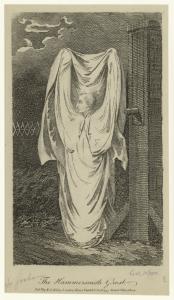Just seven years before the official beginning of the Regency era, a ghost was haunting Hammersmith. Rumored to be the spirit of man who had committed suicide, the ghost was said to have claimed victims who died from sheer fright.

So frightened was the local population, that local excise officier Francis Smith went on the hunt armed with a blunderbuss. Unfortunately, he mistook local bricklayer Thomas Milward (in his white overalls and probably covered with dust) for the spectre and shot him. Milward died from his injuries and Smith was sent to Newgate and tried and convicted for murder at the Old Bailey.
The trial was somewhat sensational. The judge had urged the jury that no matter how despicable the act of terrorizing the neighborhood was, Smith had no right to take the law into his own hands and shoot the offending ghost. After deliberating for over an hour, the jury returned with a verdict of manslaughter to which the bench took immediate issue with.
Mr Justice Rooke said “The Court have no hesitation whatever with regard to the law, and therefore the verdict must be ‘guilty of murder,’ or ‘a total acquittal from want of evidence.'”
Mr Justice Lawrence said: “You have heard the opinion of the whole Court is settled as to the law on this point, it is therefore unnecessary for me to state mine in particular. Upon every point of view this case is, in the eye of the law, a murder, if it be proved by the facts. Whether it has or not is for you to determine, and return your verdict accordingly. The law has been thus stated by Justice Foster and all the most eminent judges.”
The recorder said: “I perfectly agree with the learned judges who have spoken. Gentlemen, consider your verdict again.”
The jury then turned round and, after a short consultation, returned their verdict “guilty.” (Newgate Calendar)
The case captured the imagination of everyone, and was made all the more incomprehensible when the real “ghost” was discovered to be a father who had “haunted” Hammersmith as revenge for someone telling his children ghost stories.

Although Smith was found guilty, he fortunately avoided his sentence to hang.
The prisoner, who was dressed in a suit of black clothes, was then twenty-nine years of age, a short but well-made man, with dark hair and eyebrows; and the pallid hue of his countenance during the whole trial, together with the signs of contrition which he exhibited, commanded the sympathy of every spectator. When the dreadful word “guilty” was pronounced he sank into a state of stupefaction exceeding despair. He at last retired, supported by the servants of Mr Kirby.
The Lord Chief Baron having told the jury, after they had given their verdict, that he would immediately report the case to his Majesty, was so speedy in this humane office that a “respite during pleasure” arrived at the Old Bailey before seven o clock, and on the 25th he received a pardon, on condition of being imprisoned one year. (Newgate Calendar)
Ironically, or perhaps fittingly, the ghost of slain Milward is now said to haunt the pub were he died even some 200 years later.










Old trial descriptions are so fascinating!
“pallid hue of his countenance during the whole trial, together with the signs of contrition which he exhibited, commanded the sympathy of every spectator”
Classic.
Fascinating!